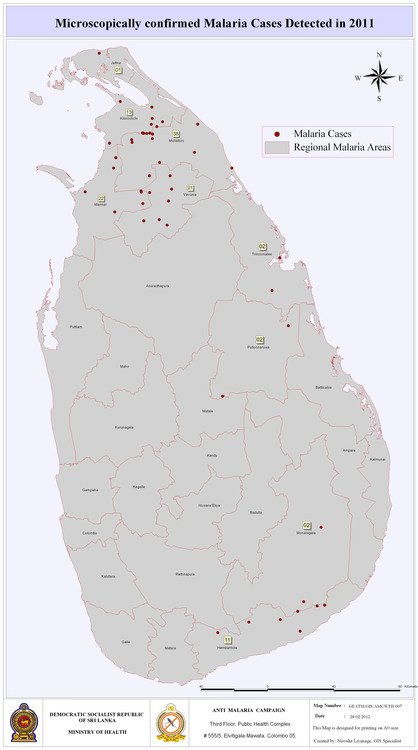when our young adult guests came to visit from Guatamala it was like having my own children around. I realize I become instantaneously maternal-I hope not in a creepy wipe the food off your face with my spit way-but rather: I hope that you grow up to be happy, productive people and let me help…
Sheet-a-faction
Got a new bed yesterday. Things are looking up, but can’t get no sheets. I can’t get no sheet-a-faction. Spent all yesterday looking for big sheets.
Off to the tailor to sew two double size sheets into one queen size sheet.
It’s hot here.
Work
The last week I’ve been working truely 9-5 at Borderlands. I got a raise that boosts me up to about $460. The value of two thai migrant laborers is how I prefer to look at it. Depreciation aside, it’s a very good salary for many Sri Lankans, and nothing that I have right to complain about.
But in many ways, it’s still not commensurate with cost of living here or my work. I can make $460 in a week in the US working at a temp job, which is not ideal either. Anyways, that’s not the point of this blog-rant.
Work has been draining. Draining in ways that are wholly unlike the US. I can’t just say print 1 big poster, 10 smaller posters and 1000 flyers to my coworker, a graphic designer. I have to say: Print 1 A1 size poster, 10 A3 posters and 1000 A6 flyers. Then, I have to explain exactly what the sizes are for the A1 etc. Then, I have to specifically label what I want to print. Then that becomes too difficult, the printer doesn’t know the sizes either. There are so many difficulties on each level that working here is incredibly frustrating to my delicate western sensibilities of productivity, initiative and efficiency.
W, our manager was designing posters and splicing video himself because he doesn’t trust our staff to make it. We have a distinct lack of talent for marketing to Western senses. Also, our staff seems to mysteriously disappear for extended periods.
That’s all.
Sadu Sadu Sad!
“Sadu Sadu Sadu Sad!” came the shout.
“Sadu Sadu Sadu Sad!” came the reply.
One group of pilgrims would yell to another, “Sadu Sadu Sad!”
Down the mountain, hundreds of yards, came the distant but clear reply, “Sadu Sadu Sad!”
At 11:30 pm on new years eve we began our ascent of Adam;s Peak, one of the holiest sites on the Island for Buddhists and Christians. At the very peak is a small Buddhist shrine, surrounding a curious rock formation, said by Buddhists to be the footprint of Buddha, or by Christians to be of St. Thomas Aquinas.
At midnight we spotted a tea shop near the base of the mountain, had cups of hot tea to steel us for the chilly climb ahead, and cheered the new years with strangers, and the vendor.
As our van winded its way through bumpy mountain roads, in Sri Lanka’s rumpled heart, we caught glimpses of stunning views in the deep dark. Nearly four hours into our journey, turning a corner, we saw Adam’s peak for the first time. The trail of maybe 5000 steps that leads it’s way to the Mountain’s peak, is lit brightly against the night sky and looks much like the tip of an ant trail winding its way across your apartment wall.
Seven kilometers later and a couple thousand feet difference in elevation, we completed our trek. At the base, the climate is warm and temperate, and remains that way until near the very top, where you feel warm (mostly from your own expenditure of energy climbing). But at the very top, after your heart rate slows, the windchill makes itself known. If you’re like me, and hiked in a bathing suit, you soon realize how dumb of an idea that was. With three and a half hours to sunrise, we huddled together at the top for warmth.
Sheela and I decided to go a third of the way down the mountain, including the most difficult final stages to grab a bottle of water and a cup of tea from one the last, highest up the mountain refreshment station.
We returned with half and hour to spare before the sunrise. Our legs were certainly numb. When the sunrises, Adam’s peak’s shadow often forms a a second faux peak, which quickly moves across the horizon as the sun continues its ascent. Unfortunately, we did not see the faux peak, but the view was stunning, and you can see, I think, all the way to near the coast of the Island, including all of the central mountainous zones.
After staying at the top for the better time of an hour after daybreak, we made our way back down. The innumerable stairs are not pleasant for the knees, so we ran down. I recommend climbing during the daytime. It’s warmer. There are less people, and you’ll get great views both on the way up and way down.
Makebelieve in Nowhere
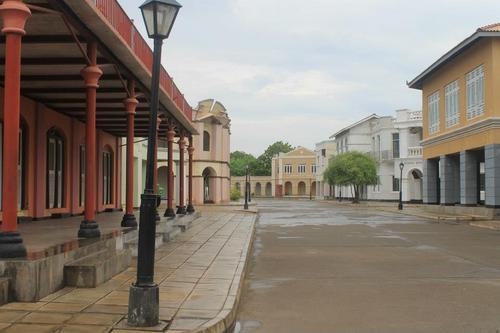
(City in the jungle.)
We went off in search of Mahinda Rajapaksa TeleCinema Park, Sri Lanka’s new big 250 acre location designed to draw filmmakers the world over to shoot in Sri Lanka.
Great idea, right? Innovative—driving economic development through film, right? The downside?
It’s empty.
Entirely empty.
In the middle of the jungle. This Telecinema complex is 20 miles from the nearest town of 2,000 people, as about as far as you can get from Colombo. The biggest “city” in the region is Hambantota, pop. 11,000.
Named, like everything else here, after the Rajapaksa family, the family that essentially runs Sri Lanka’s. Mahinda, it’s benefactor and creator is also the President, probably for life. (He’s eliminated term limits).
But the Rajapaksa vision can be a bit interesting. The President’s hometown of Hambantota has now been turned into Sri Lanka’s largest construction site. The region is literally ablaze with new monstrous building sticking out of the jungle. What was once a little town where the shops closed at sundown will, for no other apparent reason than it being the President’s hometown, be the ill thought out center of what I call “Rajapaksa Dream Land.
The cineplex has a mock town and a city (front of buildings only), a lake and a studio. Renting out the city or village is something to the tune of Rs. 5000 per day, and the studio I think is Rs. 10,000 per day. So, between $40-80 a day. Quite the steal.
But who the hell would literally go out to the middle of nowhere to get their films/commercials etc filmed? Turns out. No one, really.
To date, only one international film has filmed here.
How has business been, I asked our tour guide. With a shrug and a shy laugh, she responded “It’s…ok”
The project comes at the immense cost of Rs. 1.5 billion of which Rs. 750 million has already been invested, funded almost entirely by the country’s very high import taxes on movies and DVD sales here.
With Chinese support, labor and loans, the president is constructing a harbor designed to fit the world’s largest ships. The downside? The harbor is not deep enough and will need to be constantly dredged at extreme cost. It also ignores the fantastic deep water port of Trincomalee, a majority Tamil city.
He is constructing an international airport. The downside? It’s in a jungle in the middle of nowhere. Literally. Just google map “Hambantota International Airport”
Which is where the nation’s second airline, Mihin Lanka, a Rajapaksa pet project will be based out of. The downside? Mihin Lanka has been losing hundreds of millions of rupees a year.
The list goes on. It seems that Hambantota will be the next capital city of the country at this rate. It is the focus of pretty much every major development project in Sri Lanka.
Building a cineplex here makes just about as a building an international airport, or an internationally sized cricket stadium, in the middle of the jungle, which is exactly what the Rajapaksa family has done.
It’s shocking that I see such little resistance and opposition to these delusional dreams. The ‘whys’ of that is a blog for another time.
Some more on Ramzan
He was born on Mannar island. He fled the Island with his family when he was 16 when the LTTE took the Island during the civil war and threatened all non Tamils.
Beautiful Skin at the Gym
“You have such beautiful skin.”
Why, because my skin is white?, I think.
I had just taken off my shirt in the changing room. My extreme farmers tan contrasted heavily with my otherwise near translucent whiteness.
“No, my skin is awful. I get burned. I can get skin cancer very easily”
“But it is such beautiful skin,” said the trainer at the gym again.
At least, I can say, after I put my shirt back on, that his line of questioning is not creepy like it could be. It’s just a statement of fact. Much better than my Indian stalker at the gym at U. Hyderabad two years ago, who insisted on visiting my hostel. I obliged, and when I told him I would see him later and that I was going to take a shower, to which he said “Oh, you have nice body.”
That was awkward, and also vaguely creepy.
This was different, like he was just informing me of something that might be important to know.
Tuk tuk Driver Ramzan
He never foresaw himself driving a tuk tuk.
Three years ago his business crashed. He was working in importing, with a small retail shop. “And I lost everything,” he says.
Now, he has turned to driving a tuk tuk for his livelihood, which he says he can make up to 3000 lkr a day on. At about $23 a day, that’s a handsome salary. (And coincidentally, about twice what I make). Petrol, however, eats up a significant portion of his income.
“But I don’t have much time” to be a driver, he says, “I need to study.” He began his career as a government servant, and then moved into business. Now, he’s getting a certificate to be a manager in the tourism industry from a Canadian institution.
Tuk tuk drivers are an interesting sort of people, if I can be allowed to stereotype them. T-shirt wearing, little to no English skills, and quite a bit of paan chewing. It’s a low skill and very cutthroat job. Competition is fierce, and sometimes violent. We’ve been in tuk tuks where drivers have had public spats with others. (In one instance, our driver attempted to intimidate another tuk tuk driver off the road, and then stepped out of his tuk tuk in what could have easily become a brawl with the other driver, as our tuk tuk kept rolling.)
Ramzan is different. His appearance is put together. He wears slacks, a button down, and a watch. He carries a nice phone and his facial hair is cropped nicely into the many scruff you see many fashion models sporting. What really sticks out is his command of English—which the first time S and I rode with him, he said was “poor.” I beg to differ—the English when he next is exquisite, none of the hi, how ru” stuff.
In other news, our refrigerator is broken and repairmen came today to fix it. This is a task that Ramzan, in another life, could have done. Seeking to add another string to his bow, he said he once got a certificate in refrigeration repair. “I know the theory, but can’t do that practice.”
On a metaphysical level, the routes in which our actions in circumstances take us in life are interesting. What’s the difference between a refrigeration repairman, government servant, tuk tuk driver and a successful businessman?
In the future, he hopes to open a business in Dubai, in the tourism sector. I wish him all the best.
Christmas in Colombo
Incessant Christmas music and santa hats abound in this rather tropical climate. Christmas comes early in Sri Lanka, and in full force.
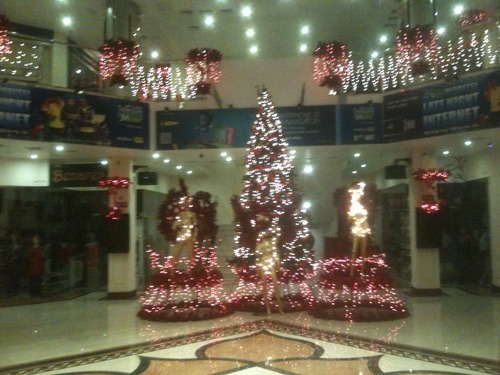
But people are in decreasing numbers Buddhist, Hindu, Muslim and then Christian.
So, why all the cheer?
(Please make it stop. It makes me uncomfortable.)
Everything is Christmas. In every mall, in many work places, in every grocery store, in cafes. Hop in to Java cafe, and they’re playing Christmas music. Want to go to a mall? Christmas music. Need groceries? You’re store clerk is wearing a santa hat. There’s even a store on Duplication road devoted entirely to selling Christmas paraphernalia.
Religion plays an interesting role in this country. You’ll see on buses a image on Jesus adjacent to one of Buddha, or a line of Hindu gods and goddesses, all brightly lit. Tri-shaws/tuk tuks are equally multi-religious. There may be strong overtones of Buddhist/Singhala militant nationalism, but it certainly doesn’t preclude the adoption and integration of other religions into the mix—even if they are only idols and partially understood holidays.
Now, all we need is snow.
Sri Lankan Work Style
Work, what is that?
It’s lunch time now in the office and the workers are settling down to chow into some rice packets. I think this is their second lunch. There’s certainly plenty of web browsing and facebook checking and smiles and giggling. The whole office is now looking at something funny on someone’s computer. My desk in the center of the office, so I get to observe all the action. Normal office culture.
*Begin Rant*
Yesterday the managing director came in a berated one of the Sri Lankan employees for not initiating a bank transfer. Apparently it was something that had been sitting around for a while, and the managing director had promised it to his colleague. All the Sri Lankan needed to do was was get the director’s signature, something he had not done.
As we have learned with Lanka Bell, things operate on their own time here, irrespective of the wishes of foreigners. Western notions of urgency certainly don’t apply, not that that comes as a surprise. It’s certainly something that I’m used to given past experiences in Africa and India, where, for instance, I’ve been on trains over 8 hours late.
What is frustrating is the uniquely Sri Lankan promise of a service which is not delivered, repeatedly. We get it that things are slow, but promises that are not kept are eminently frustrating. When we remind them that they promised us something, we usually get another promise that we know can’t be true. An, “ok ok” with a glazed over look rather than a “Sorry, I’ll get it you later.” Continual promises, four or five times over, none of which are kept. In the case of internet, someone has to stay home, just in case they do arrive.
The surprising next thing is that when they arrive *ahem Lanka Bell* they call us five times within a few minutes. Yes, you don’t reply for days that turn into weeks and drag your feet, and then for the 15 minutes we’re not around, everything becomes incredibly urgent.
Rant over.
Adam’s Bridge with the SLN
The waves were choppy, and as our skiff was rocked roughly by them, the crew member operating the motor yelled in Sinhala to his captain that we had a bit of problem. Sheela had her eyes firmly shut in an intense I-will-not-vomit-concentration on our return trip from Adam’s Bridge, the 36km wide chain of shoals, islands and sandbanks that connects India to Sri Lanka. Faring better, I turned back to examine the problem, which was that we were taking on water.
The plug in the back of the boat had popped out (in this case, a crudely fashion cylindrical piece of wood). We weren’t exactly in danger of sinking, but I gathered from their conversation that the building water levels could swamp the lowly placed motor (this 40hp motor used a kerosene and petrol mix). Small skiffs have a plug that fits into the rear of the boat, which makes for a convenient way to drain water from them. As you increase the boat speed, the front end will rise off the water and any water in the boat will drain from the back. Eventually, at higher speeds, the boat will “plane” and become level again.
The captain asked me for a handkerchief to plug the hole, which I didn’t have, so he whipped out a pocket knife and started whittling away at the plug. Crisis averted.
Until 1984, there was a ferry that operated between the two countries, and for a few months in 2011, it reopened. Now, the Sri Lankan Navy offers tours of Adam’s Bridge going out 10km from their base in Talaimannar to the second island from the Lankan side. On clear days you can see India. The sailors were a good natured bunch and tld us in 2015 the ferry should resume.
The islands are beautiful, and it took us about 1hr to get to the second one. They are desolate, white, treeless and you really feel like you’re at the end of the world: the type of place that someone more spiritual than I would say they could “find themselves.” Enough with waxing poetic, I’d say the spiritual seeker would die of thirst. Some good photos later, and with Sheela impressing the Sri Lankan Navy seamen by spelling her name in Sinhala in the sand, we returned.
Traveler’s reports and lonely planet are sorely wrong on the details of the tour. You DO NOT get lunch, or water, and it DOES NOT cost 600lkr per person. The tours are priced instead by boat, at 3600lkr per boat. I had a bit of fun in helping them push the skiffs out to sea before we got on them. See, I can join the armed forces too!
The Road to Mannar / Vavunia!
The road to Mannar Island, the A14, is supremely different than it likely was five years ago, and will be unrecognizable in five more years. Every fifty meters lies the remains of a Sri Lankan Army post. These posts, placed at such intervals, and the road they are on, acted as the line that kept the LTTE out. The road is undergoing incredible construction. Now it is a black tar road just wide enough for two buses to fit by each other. In five years it will be an American-like highway, with a wide median—wide enough that I saw someone house and farmland in between the sides.
We took this road out from the border city of Vavuniya on Saturday. A bit about Vavuniya: It is a majority tamil city with not a whole heck of a lot to see, but there is something peculiar about it, besides from being the last city on the way to the former border. Just about 3km to the east of the city is a Buddhist monument famous for holding Buddha’s “sacred tooth” sometime around the 4th century CE on it’s way from India to Sri Lanka. The city also has a neat mosque, but that’s about it. Oh, the cargills had some interesting beer, including an Irish Dark Red Stout, which I’m curious to try.
Our hotel, shall we say, had some character. The toilet (which unintentionally auto-drained) flushed only under the condition that you fill a bucket of water and poured it into the tank. Hot water existed only in the afternoon, presumably when the sun had heated the water up. Sorry, no “hot rod” here! There was no shower head, just a pipe. The room had three beds of varying sizes, all in different stages of destruction. The pillows smelt of must and dirt, the type that your grandmother has at her house that haven’t been washed in 10 years. The fan had two settings: decapitation speed and off. Most of strange of all was the entrance: the hotel was buried at the back of a narrow alley way. Other than that, it was a great place designed more for Sri Lankans than tourists.
Why did we choose it? It was the only place open at 6am. Good business policy. The other hotels should think of opening when the night train gets in. For 1500, LKR, I suppose we can’t complain.
Mannar Island is something else. It has a big Baobab tree, planted by Arabs in the 15th century and a whole ton of DONKEYS. The island was heavily fought over, all muslims and sinhalese at one point were evicted by the LTTE, and is still dotted with mines and the usual detritus of war. We left early morning from Vavuniya, barely catching the first bus out on Saturday 6am. Buses out here are not numbered, so don’t even try to make sense of them—you just have to ask people, and ask and ask and ask—until you find someone who knows what they’re talking about and when the bus will actually depart. Immediately after arriving in Mannar we went to Talaimannar.
To the Border!
The Sri Lankan Army (SLA) base commander looked at us strangely, clearly not comprehending that we had come to see the checkpoint, and not to travel beyond it. But they “have freedom now” he said of the people living north of the checkpoint, the checkpoint that once formed the border between Sri Lanka and Tamil Eelam.
This weekend, Sheela and I decided to head to Vavuniya (pronounced: Vowniya) and to Mannar. These two places are quite unique in Sri Lanka.
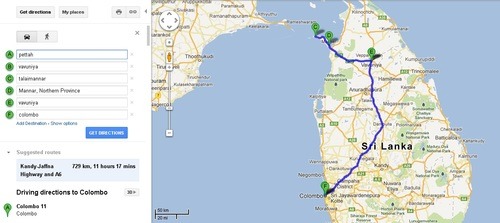
And so we found ourselves at the old border between Sri Lanka and Tamil Eelam in attempt to do a little tourism of Sri Lanka’s history. War tourism might be problematic, especially for people to make an industry off of the suffering of others—but this, I think, was a bit different—we wanted to see the old border and the old checkpoints (both Sri Lankan and Tamil Tiger). This border is important in Sri Lankan history for it’s obvious traumatic implications and it’s something that a self respecting foreigner living here should strive to understand.
Furthermore, for Sheela’s film research purposes, the war features in some manner in virtually every movie that she has watched. One called Under the Sun and Moon, describes the story of a mixed Sinhalese, Tamil couple that was split by the war. The plot’s a bit complex, but the basic idea is that the husband met his future wife while he was in the Sri Lankan army. His had just killed the wife’s brother, a Tiger and his superior officer, furious at deaths in his unit, guns down the wife’s parents for harboring the Tiger and then trains his rifle on the wife. The husband saves her life by putting his gun to his superior officer. They marry and have a kid but the husband dies later in the war, and the wife goes back to Tamil Eelam with their child. The child has a medical condition that requires the kid to go Colombo under the care of an uncle.
The final climactic scene involves the uncle driving to the border to bring the child back to his mother, as artillery fire is landing around them. The checkpoints are big and imposing, with significant fortifications—and something, we thought by watching the movies, worth seeing.
(Under the Sun and Moon is a heart wrenching movies in a Sri Lankan style that portrays evil and humanity on both sides of the conflict.)
With the images of the border in our mind, we set off for the checkpoint. Thinking it would be a cool idea, we first started walking from Vavuniya. Only to discover, 5km in, after a bit of a map reading error (my bad) that the border was at Omanthai, about 30km up the road. Omanthai is a small village with maybe a couple dozen houses and shacks and maybe a petrol station.
But there are no border checkpoints anymore, only three years since the war ended. They’ve all been removed. The only thing left is a small checkpoint run by the SLA which notes down your passport information. That’s all. The officer, confused by our reason for visiting, called in the base commander, who explain in English that we were welcome to walk around as long as we didn’t take any photos.
There’s nothing left to see. So we turned around to Vavuniya, nerves a little shaky at being present with so many army men and their machine guns.
Jackfruit for Dinner
We had jackfruit for dinner. That’s a jackfruit. It’s bigger than my head. A LOT bigger than my head. (Our jackfruit was small, about the size of my head). But you see HUGE jackfruit in the markets here for dirt cheap.
My mother says I should never eat anything bigger than my head. But it was oh so tasty in this recipe. Tastes just like chicken: http://cleangreensimple.com/2011/06/jackfruit-carnitas/
We’re planning a thanksgiving feast here—I know what I’ll be making.
One Month In: A Perspective
You may be wondering what exactly I’m doing in Sri Lanka, why I am here, what my raison d’etre is. I hope this post clarifies some of these FAQs.
Sri Lanka is something else. I’ve lived in foreign countries before, on my own, and with study abroad—so it’s nothing I’m not used to. I think most of all, though, is that this is the first time I’m living overseas on my own for an extended period of time. It’s definitely fun and exciting and I’m enjoying all of it. Just last night there was a Diwali celebration on the street outside our house. it’s basically like this long parade with banging drums, dancing and fireworks—you know the kind of drums in Lord of the Rings when the gremlins come up with their cave troll in the mines of Moria. THUMP THUMP THUMP.
From the way tuk tuks/3 wheelers have meters and the their obeisance to traffic signals, to cuisine and culture, Sri Lanka is different from India in many stark. It’s more than that people don’t generally try to rip you off that makes Sri Lanka “India Lite.” There’s something about the “feel” here. Comparing cultures is always a game of apples to oranges, but if one thing’s for sure, it sure as hell isn’t India. I do have to remind myself not to over-compare, as that becomes droll.
My reason for coming to Sri Lanka, the impetus for this sojourn, is Sheela. The rest, I figured, would fall into place. It has, surprisingly seamlessly. Within a few weeks I have found a steady “occupation” (working on my visa is a no-go), if you catch my drift, and I have found writing time to work on a book about the Bengal Gazette, the first newspaper in Asia. I’m in Colombo here with Discover Borderlands. Salary is $230/month as a copywriter for their website, but that goes a long way when my rent is only $96 a month.
I hope to complete this book project sometime within the next year or two. Saying I am writing a book as an occupation is not something I have been comfortable with—it is kind of something I have felt defensive about—I would have to explain my project to people even when I’m not too sure about it myself. Moreover, how do I actually make 18th century English?, which is my whole point. In addition to both of these things, I have been taking Sinhalese classes with the great teacher Michael Meyler so I’ve been kept very busy.
I’ve applied for a Fulbright to do research on British Colonial Newspapers and the Bengal Renaissance in Calcutta, so fingers crossed for next year if I’m lucky enough to be accepted!
Enough writing for now. The midday heat is coming on, and things slow down due to its overbearingness. Over and out, folks.
Country Roads And Country Music
My obsessive quest to figure out why all Sri Lankans know and love John Denver’s Country Roads has taken another turn. I first discovered this phenomena when they all knew the lyrics during Octoberfest here. Sheela just came across the Sri Lankan movie, Sisila Gini Gani, fimed in 1992. Some of the characters started singing “Country Roads”. This movie was filmed in 1992. So their love of this song has gone back at last 20 years.
I think I’m getting somewhere…
Also, in case you’re curious, you can easily find American country music on Sri Lankan radio stations. Why? I have no idea.
3AM Diwali
Just last night there was a Diwali celebration on the street outside our house. It’s basically this long parade with banging drums, dancing and fireworks.
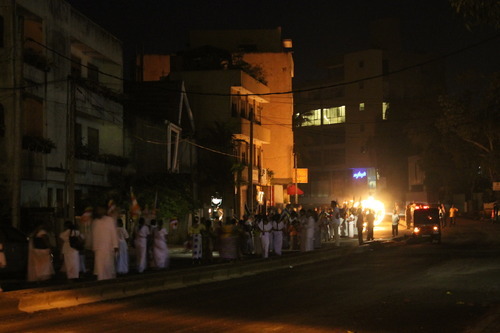
Diwali is a Hindu celebration of the return of the Hindu god Rama after his 14 year exile from someplace that I’m not familiar with. Moreover, Ram defeats Ravana, who so happens to be the King of Sri Lanka. So, potentially a bit touchy that you’re celebrating the killing of Sri Lanka’s king.
You know the kind of drum in Lord of the Rings when the gremlins come up with their cave troll in the Mines of Moria? That kind of drum. THUMP THUMP THUMP. Up from the deep.
Anyways, as I stumbled out of bed at 3am in the morning, I was mildly annoyed that these Hindus would have the gall to began a beating, bashing, banging procession of loud discordant noise. However, I was really annoyed that they had disrupted my normal midnight pee spot in the private garden in front of our house. How’s a man to whip it out in the “bright daylight” (thank you, fireworks and gigantic sparkler things) of 3am Colombo when there are three hundred Sri Lankans outside his door?
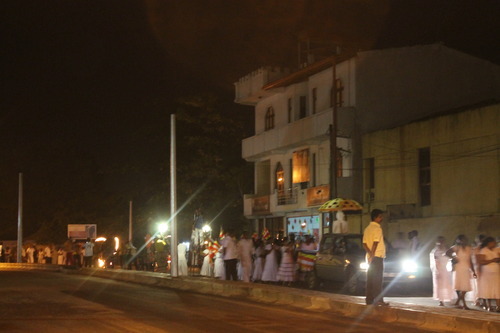
Disrupted pee spots aside, more culturally interesting about this Diwali celebration is that for some reason in Sri Lanka the Hindus celebrate Diwali with a icon of Buddha and a whole bunch of Buddhists flags, which is totally strange to Sheela and I, who have never seen the two religions conflated in such a manner.
My conclusion: A great holiday and “festival of lights” for the everyday insomniac and night creature. Not so great for normal sleep patterns.
Untitled: My purple marriage
Sheela informs me that I can “reblog”. So here it is…mindyotis:
My first memories of a political election would be when I was in elementary school. I remember learning all about the Nixon-McGovern presidential race in my DAP class (divergent activities program-a nice way to say talented and gifted so we didn’t feel so elitist) At the time I recall everyone was…
The Rickshaw Driver
He had three sons. Only one son is still living.
Two died in the civil wars.
The Liberation Tigers of Tamil Eelam (LTTE) killed his first son. The Sri Lankan Army (SLA) killed his second. His wife died of a heart attack in 2009.
He has only one son left. He has no family. His family, he said, “is his church.”
You can feel how real the war is, in the East. Minefields still kill, perhaps 120 in the last year. Almost everyone has been affected. Batticaloa suffered its share, being a hub of Tamil culture. (The civil wars in Sri Lanka were between ethnic Tamils in the North and East and Singhalese in the South and West.
On June 11, 1990 the LTTE massacred 600 police officers. LTTE soldiers surrounded the Batticaloa police station, separated the Tamil and Sinhalese officers, and brought the Sinhalese officers deep into the jungle in the Northeastern part of the country. There they tied the hands of the officers and shot them, leaving the bodies in the jungle. This atrocity existed among others committed by both sides during the twenty year way that divided the country.
The Singhalese Government defeated the LTTE after those long years in 2009. As I anticipate further trips to the North and East, I expect to see more damage from the civil wars. Most of all, I have noticed how hidden the damage is—you have to search to see it. Still, I am a newcomer and expect to learn more.
But, things ended on the brighter side with the rickshaw driver, as I hope they will remain for Sri Lanka. When asked, “what is your favorite thing about Sri Lanka?” He replied, “I love the shrimps.” The man’s got his mind in the right place.
Of Minefields and Movies
Our goal on Sunday was to reach one of Batticaloa’s famed, and empty, beaches. This was quickly stymied by the realization via Lonely Planet that to reach the beach the long way you have to pass a “well-defined minefield” to reach the beach. MINEFIELD!?!?! Well defined my ass. I’ve been in South Asia long enough to know that’s never the case. One wonders what could have happened if we had decided to try our shortcut…
Instead we decided on the much tamer option of watching a movie in Tamil, the language of most Batticaloans, and the language of the regional film powerhouse from Tamil Nadu, India Kollywood. Don’t ask me why it’s called Kollywood. Ask Sheela. Perhaps Telugu already got Tollywood?
Something strange, and makes absolutely no sense to me is that the movie was dubbed. Yes, it as a Tamil movie, and the audience (with the exception of us) was all Tamil. It’s like watching Harry Potter only to find that Harry, Rob and Hermoine’s voices have all been dubbed by other people speaking English. What the fuck?
I, still determined to see the ocean by any means possible, took a detour and walked to a beach. Absolutely gorgeous, and desolate, with fishermen’s boat sitting upside down on the beach. (This is the same beach the suffered tremendous damage during the 2004 tsunami) I sat down under a large tree for some quiet contemplation and reading. Next to me was a large Sri Lankan family. Faintly I heard the words “Where are you from?” Looks like I was about to become the center of attention, so I decided to ignore the question.
A few moments later I glanced up and noticed a girl walking in front of me, then around behind my bench. She asked, “Can I see your book?” So I show her, but she takes it from me! And with it, she runs back to her family, all giggling.
Great, guys. You took my book. Thanks.
Like a tempest, the family then rushed over to me, and crowded close around me. perhaps 20-30 in all, but only the girl could speak some English. The rest just asked me my name. All in all, lots of giggling and a genuinely heart warming experience.
They did give me my book back, and I enjoyed the beach in peace.
Now, I just went out to buy Sri Lankan ice cream. Sri Lankan ice cream is probably the most delicious store bought ice cream that I know of in the world—try the mango flavor. It’s time to consume a liter or two…Signing off.
Over to Batticaloa
This weekend we went to Batticaloa in the east, leaving Friday night and returning on Sunday. Batticaloa has a frontier feel, untrammeled by outsiders.A lazy city of 100,000 people, it sits on the Indian Ocean, and hosts a vibrantly diverse community of Tamils, Muslims and Burghers.
We took the bus overnight there and found the journey to be incredibly crowded. The government bus—these are all painted red. Private buses are painted white. Every inch of isle space taken up and every seat occupied. There’s only so much sweaty arm pit in my face that I can stand. It’s also important to defend one’s leg space, as your knee can look like valuable real estate for someone else to rest their arm on if they are sitting in the isle. Thank god this isn’t India. More disturbing was the fight between a drunk father who two girls were visibly upset and crying and the ticket master. This weekend was a “poya” weekend and also Eid, so the entire country is essentially on vacation. Poya is a holiday that occurs with every full moon.
Arriving in the early morning, we set out immediately to find a guest house to find the first few all full. No matter, we started walking past the UN building, among other post 2004 tsunami development work buildings and encountered some wild dogs. Wild pack of family dogs?
That afternoon we did some exploration around the town and went to visit an old Dutch fort that had been built at first by the Portuguese (the Dutch took it over and expanded it). Lord knows how they got anything done in the heat. 10 minutes out in the 6deg north of the equator and I’m already sunburnt enough that I have to spend the rest of my trip hidden under an umbrella for shade—life here for my pale skin is like living like a vampire, I can only come out at night, or I’ll melt.
In the afternoon we set out to a lighthouse built by the British and a public park/beach north of town. It’s absolutely gorgeous and we get to climb to the top of the lighthouse for a great view at dusk. Thereafter we went to the riviera lodge for some sri lankan curry before heading in for the night.
Being Poya, we arrived at our hotel confronted by a Sri Lankan family who invited us to dance with them. An hour of bad dancing later, we, especially Sheela, had become the stars of the show. Of course, they asked the “baendela” question. That means, “are you married?” to which we replied disjointedly. A bit of singing and dancing. Girlfriend and boyfriend often don’t go here. You’ll get some strange looks if you say that so in so is your significant other. (I think that this is generally not always the case/is changing. May people will understand you if you say boyfriend or girlfriend) I got the rather awkward question, “Oh, so married but virgin?” Time to sort out that mess…
Strange Fruit of the Day
Yesterday’s strange fruit of the day: Dragonfruit.
Signs for Roadwork
They have signs for roadwork!?!? Definitely not India.
Water Feature
Why does the water feature at the Irrigation Department have no water?
Shangri-La Singhala
Shangri-La, where there are Sinhala classes with the ETAs and Fulbrighters. The ETA’s live in a beautiful compound in the south of the city. They’re here for a month and then go their respective ways around the country to teach English.
Sinhala is pronounced “singhala” because you’re supposed to sing it. Jokes.
Why Is there South African Cereal In Sri Lanka
Why is there South African cereal in Sri Lanka? Found in Cargills on Jawatte Rd, Colombo 5.
This one’s for you, mom
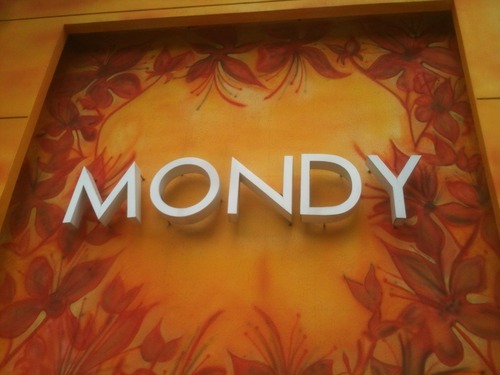
Malaria in Sri Lanka
Today at the Library
Today I decided to head out to the nearby “magical American library”. Indeed magical because it resides in the second story of someone’s house. But, that’s only if you find the correct library. My housemates and I have been looking for a library to haunt, in our search for a good study space. Rumor had it there was an “american library a short walk away.
What should have been a five minute walk to Sulieman ave to find the “American Library” turned out to be quite the adventure. Sulieman ave is a curly cue shaped street with a bad case of erectile dysfunction. It also has four or five unnamed little side streets that branch off of it. I walked on down to the tip of street, passed all the little side streets and found nothing, except some rather aggressive feral dogs. Trudging back to the beginning of the street I began the usual game of asking the locals where this said “American Library” was. A couple of tries later, I was directed to a “Social Science” Library, whatever that means, disguised quite well as someone’s house. After visiting the 1st floor bookstore, I Found the library, which I discovered was not in fact the American library.
So, I wandered out with a vague sense of where I needed to go next, and lo-and behold I see a white man! Very academic looking, too. Now, I’m on to something. I walk up to the house he came from and ring the bell, and am invited upstairs to the “American Library” office, where I’m told to go next door for the actual library. Unfortunately, the next house turns out to be just that: someone’s house (a duplex), and an irate old man in a lungi comes out to inform me that I need to go exactly back where I came. Bleh.
In the end, I do find the library. It’s the second floor of the duplex next door, above a small sign that reads: “American library upstairs. Ring the bell.”
In other news, I have been participating in Sinhala class with the Fulbrighters. Great fun as the teacher is a brit expat named Michael. It’s located in the south of the city in a neighborhood called Pepilyana, near Mt. Lavinia. We have classes in the guesthouse where the English Teaching Assistants stay (ETA’s), called Shangri-La. Very nice.
Oktoberfest In Sri Lanka
Oktoberfest in Sri Lanka!
The beer maiden strided by, six one liter towering steins of lager nestled in her arms. Meanwhile, a band played songs in German dressed in Lederhausen. Ah, Oktoberfest in Sri Lanka. While little bit kitschy it certainly was fun. That, and the very strangely colored Chernobyl green dye that some of the beer had. Sheela and I went there on her Birthday while we met her friend Karmini a fellow Fulbright scholar.
Fun as it was, someone please tell me why did all the Sri Lankans know the lyrics to John Denver’s Take Me Home, Country Roads?
